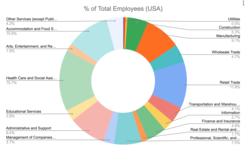This article needs additional citations for verification. (October 2023) |


| This article is part of a series on the |
| Economy of the United States |
|---|
 |
The labor force is the actual number of people available for work and is the sum of the employed and the unemployed. The U.S. labor force reached a record high of 168.7 million civilians in September 2024.[1] In February 2020, at the start of the COVID-19 pandemic in the United States, there were 164.6 million civilians in the labor force.[2] Before the pandemic, the U.S. labor force had risen each year since 1960 with the exception of the period following the Great Recession, when it remained below 2008 levels from 2009 to 2011.[2] In 2021, The Great Resignation resulted in record numbers in voluntary turnover for American workers.[3]

The labor force participation rate, LFPR (or economic activity rate, EAR), is the ratio between the labor force and the overall size of their cohort (national population of the same age range). Much as in other countries in the West, the labor force participation rate in the U.S. increased significantly during the later half of the 20th century, largely due to women entering the workplace in increasing numbers. Labor force participation has declined steadily since 2000, primarily because of the aging and retirement of the Baby Boom generation.[citation needed] Analyzing labor force participation trends in the prime working age (25-54) cohort helps separate the impact of an aging population from other demographic factors (e.g., gender, race, and education) and government policies. The Congressional Budget Office explained in 2018 that higher educational attainment is correlated with higher labor force participation for workers aged 25 to 54. Prime-aged men who are out of the labor force tend to be out due to disability, while a key reason for women is caring for family members.[4]
- ^ https://fred.stlouisfed.org/series/CLF16OV/
- ^ a b "Civilian Labor Force". FRED. January 1948. Retrieved March 26, 2020.
- ^ Serenko, A. (2023). "The Great Resignation: The great knowledge exodus or the onset of the Great Knowledge Revolution?" (PDF). Journal of Knowledge Management. 27 (4): 1042–1055. doi:10.1108/JKM-12-2021-0920. S2CID 249652534.
- ^ CBO-Factors Affecting the Labor Force Participation of People Ages 25 to 54-February 7, 2018
